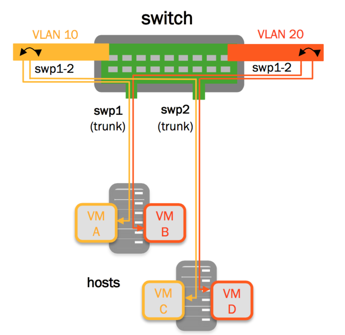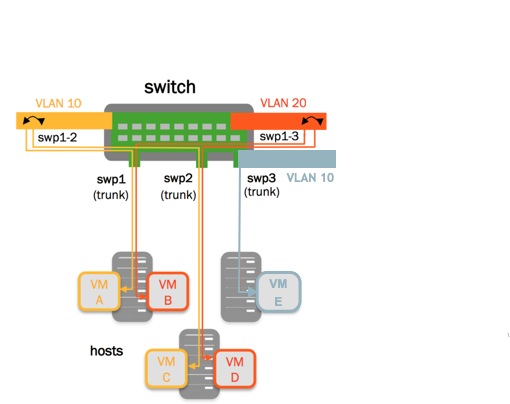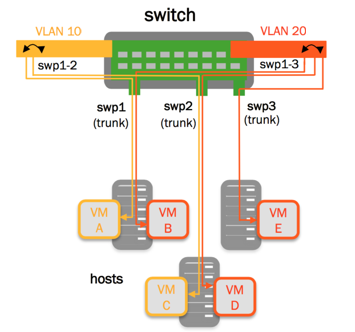VLAN-aware Bridge Mode
VLAN-aware bridge mode in Cumulus Linux implements a configuration model for large-scale layer 2 environments, with one single instance of spanning tree protocol. Each physical bridge member port includes the list of allowed VLANs as well as the port VLAN ID, either the primary VLAN Identifier (PVID) or native VLAN. MAC address learning, filtering and forwarding are VLAN-aware. This reduces the configuration size, and eliminates the large overhead of managing the port and VLAN instances as subinterfaces, replacing them with lightweight VLAN bitmaps and state updates.
Cumulus Linux supports multiple VLAN-aware bridges but with the following limitations:
- You cannot use MLAG with multiple VLAN-aware bridges
- You cannot use the same port with multiple VLAN-aware bridges
- You cannot use the same VNIs in multiple VLAN-aware bridges
- You cannot use VLAN translation with multiple VLAN-aware bridges
- You cannot use double tagged VLAN interfaces with multiple VLAN-aware bridges
- You cannot associate multiple single VXLAN devices (SVDs) with a single VLAN-aware bridge
Configure a VLAN-aware Bridge
The example commands below create a VLAN-aware bridge for STP that contains two switch ports and includes 3 VLANs; tagged VLANs 10 and 20, and untagged (native) VLAN 1.

With NVUE, there is a default bridge called br_default, which has no ports assigned. The example below configures this default bridge.
cumulus@switch:~$ nv set interface swp1-2 bridge domain br_default
cumulus@switch:~$ nv set bridge domain br_default vlan 10,20
cumulus@switch:~$ nv set bridge domain br_default untagged 1
cumulus@switch:~$ nv config apply
Edit the /etc/network/interfaces file and add the bridge:
cumulus@switch:~$ sudo nano /etc/network/interfaces
...
auto br_default
iface br_default
bridge-ports swp1 swp2
bridge-vids 10 20
bridge-pvid 1
bridge-vlan-aware yes
...
Run the ifreload -a command to load the new configuration:
cumulus@switch:~$ ifreload -a
The Primary VLAN Identifier (PVID) of the bridge defaults to 1. You do not have to specify bridge-pvid for a bridge or a port. However, even though this does not affect the configuration, it helps other users for readability. The following configurations are identical to each other and the configuration above:
auto br_default
iface br_default
bridge-ports swp1 swp2
bridge-vids 1 10 20
bridge-vlan-aware yes
auto br_default
iface br_default
bridge-ports swp1 swp2
bridge-pvid 1
bridge-vids 1 10 20
bridge-vlan-aware yes
auto br_default
iface br_default
bridge-ports swp1 swp2
bridge-vids 10 20
bridge-vlan-aware yes
- If you specify
bridge-vidsorbridge-pvidat the bridge level, all ports in the bridge inherit these configurations. However, specifying any of these settings for a specific port overrides the setting in the bridge. - Do not bridge the management port eth0 with any switch ports. For example, if you create a bridge with eth0 and swp1, the bridge does not work correctly and disrupts access to the management interface.
Configure Multiple VLAN-aware Bridges
This example shows the commands required to create two VLAN-aware bridges on the switch.

- bridge1 bridges swp1 and swp2, and includes 2 VLANs;
vlan 10andvlan 20 - bridge2 bridges swp3 and contains one VLAN;
vlan 10
Bridges are independent so you can reuse VLANs between bridges. Each VLAN-aware bridge maintains its own MAC address and VLAN tag table; MAC and VLAN tags in one bridge are not visible to the other table.
cumulus@switch:~$ nv set interface swp1-2 bridge domain bridge1
cumulus@switch:~$ nv set bridge domain bridge1 vlan 10,20
cumulus@switch:~$ nv set bridge domain bridge1 untagged 1
cumulus@switch:~$ nv set interface swp3 bridge domain bridge2
cumulus@switch:~$ nv set bridge domain bridge2 vlan 10
cumulus@switch:~$ nv set bridge domain bridge2 untagged 1
cumulus@switch:~$ nv config apply
Edit the /etc/network/interfaces file and add the bridge:
cumulus@switch:~$ sudo nano /etc/network/interfaces
...
auto bridge1
iface bridge1
bridge-ports swp1 swp2
bridge-vlan-aware yes
bridge-vids 10 20
bridge-pvid 1
auto bridge2
iface bridge2
bridge-ports swp3
bridge-vlan-aware yes
bridge-vids 10
bridge-pvid 1
...
Run the ifreload -a command to load the new configuration:
cumulus@switch:~$ ifreload -a
NVIDIA Spectrum-1 switches support a maximum of 10000 VLAN elements. NVIDIA Spectrum-2 switches and later support a maximum of 15996 VLAN elements. Cumulus Linux calculates the total number of VLAN elements as the number of VLANs times the number of configured bridges. For example, 6 bridges, each containing 2600 VLANs totals 15600 VLAN elements.
On NVIDIA Spectrum-2 switches and later, if you enable multiple VLAN-aware bridges and want to use more VLAN elements than the default, you must update the number of VLAN elements in the
/etc/mlx/datapath/broadcast_domains.conffile:- To specify the total number of bridge domains you want to use, uncomment and edit the
broadcast_domain.max_vlansparameter. The default value is 6143. - To specify the total number of subinterfaces you want to use, uncomment and edit the
broadcast_domain.max_subinterfacesparameter. The default value is 3872.
You must restart
switchdwith thesystemctl restart switchdcommand to apply the configuration.The number of
broadcast_domain.max_vlansplusbroadcast_domain.max_subinterfacescannot exceed 15996. Increasing thebroadcast_domain.max_vlansparameter can affect layer 2 multicast scale support.- To specify the total number of bridge domains you want to use, uncomment and edit the
Reserved VLAN Range
For hardware data plane internal operations, the switching silicon requires VLANs for every physical port, Linux bridge, and layer 3 subinterface. Cumulus Linux reserves a range of VLANs by default; the reserved range is 3725-3999.
If the reserved VLAN range conflicts with any user-defined VLANs, you can modify the range. The new range must be a contiguous set of VLANs with IDs between 2 and 4094. For a single VLAN-aware bridge, the minimum size of the range is 2 VLANs. For multiple VLAN-aware bridges, the minimum size of the range is the number of VLAN-aware bridges on the system plus one.
To configure the reserved range, edit the /etc/cumulus/switchd.conf file to uncomment the resv_vlan_range line and specify a new range. After you save the file, you must restart switchd.
VLAN Pruning
By default, the bridge port inherits the bridge VIDs, however, you can configure a port to override the bridge VIDs.

This example commands configure swp3 to override the bridge VIDs:
cumulus@switch:~$ nv set interface swp1-3 bridge domain br_default
cumulus@switch:~$ nv set bridge domain br_default vlan 10,20
cumulus@switch:~$ nv set bridge domain br_default untagged 1
cumulus@switch:~$ nv set interface swp3 bridge domain br_default vlan 20
cumulus@switch:~$ nv config apply
Edit the /etc/network/interfaces file, then run the ifreload -a command. The following example commands configure swp3 to override the bridge VIDs:
cumulus@switch:~$ sudo nano /etc/network/interfaces
...
auto br_default
iface br_default
bridge-ports swp1 swp2 swp3
bridge-pvid 1
bridge-vids 10 20
bridge-vlan-aware yes
auto swp3
iface swp3
bridge-vids 20
...
cumulus@switch:~$ ifreload -a
Access Ports and Tagged Packets
In the configuration below, swp1 and swp2 are access ports, while all untagged traffic goes to VLAN 10:

cumulus@switch:~$ nv set interface swp1-2 bridge domain br_default
cumulus@switch:~$ nv set bridge domain br_default vlan 10,20
cumulus@switch:~$ nv set bridge domain br_default untagged 1
cumulus@switch:~$ nv set interface swp1 bridge domain br_default access 10
cumulus@switch:~$ nv set interface swp2 bridge domain br_default access 10
cumulus@switch:~$ nv config apply
Edit the /etc/network/interfaces file, then run the ifreload -a command.
cumulus@switch:~$ sudo nano /etc/network/interfaces
...
auto br_default
iface br_default
bridge-ports swp1 swp2
bridge-pvid 1
bridge-vids 10 20
bridge-vlan-aware yes
auto swp1
iface swp1
bridge-access 10
auto swp2
iface swp2
bridge-access 10
...
cumulus@switch:~$ ifreload -a
Drop Untagged Frames
With VLAN-aware bridge mode, you can configure a switch port to drop any untagged frames. To do this, add bridge-allow-untagged no to the switch port (not to the bridge). The bridge port is without a PVID and drops untagged packets.
The following example command configures swp2 to drop untagged frames:
cumulus@switch:~$ nv set interface swp2 bridge domain br_default untagged none
cumulus@switch:~$ nv config apply
Edit the /etc/network/interfaces file to add the bridge-allow-untagged no line under the switch port interface stanza, then run the ifreload -a command.
cumulus@switch:~$ sudo nano /etc/network/interfaces
...
auto swp1
iface swp1
auto swp2
iface swp2
bridge-allow-untagged no
auto br_default
iface br_default
bridge-ports swp1 swp2
bridge-pvid 1
bridge-vids 10 20
bridge-vlan-aware yes
...
cumulus@switch:~$ sudo ifreload -a
When you check VLAN membership for that port, it shows that there is no untagged VLAN.
cumulus@switch:~$ bridge -c vlan show
portvlan ids
swp1 1 PVID Egress Untagged
10 20
swp2 10 20
bridge 1
VLAN Layer 3 Addressing
When configuring the VLAN attributes for the bridge, specify the attributes for each VLAN interface. If you are configuring the switch virtual interface (SVI) for the native VLAN, you must declare the native VLAN and specify its IP address. Specifying the IP address in the bridge stanza itself returns an error.
The following example commands declare native VLAN 10 with IPv4 address 10.1.10.2/24 and IPv6 address 2001:db8::1/32.
The NVUE and Linux commands also show an example with multiple VLAN-aware bridges.
cumulus@switch:~$ nv set interface vlan10 ip address 10.1.10.2/24
cumulus@switch:~$ nv set interface vlan10 ip address 2001:db8::1/32
cumulus@switch:~$ nv config apply
cumulus@switch:~$ nv set interface bridge2_vlan10 type svi
cumulus@switch:~$ nv set interface bridge2_vlan10 vlan 10
cumulus@switch:~$ nv set interface bridge2_vlan10 base-interface bridge2
cumulus@switch:~$ nv set interface bridge2_vlan10 ip address 10.1.10.2/24
cumulus@switch:~$ nv set interface bridge1_vlan10 type svi
cumulus@switch:~$ nv set interface bridge1_vlan10 vlan 10
cumulus@switch:~$ nv set interface bridge1_vlan10 base-interface bridge1
cumulus@switch:~$ nv set interface bridge1_vlan10 ip address 12.1.10.2/24
cumulus@switch:~$ nv config apply
Edit the /etc/network/interfaces file, then run the ifreload -a command.
cumulus@switch:~$ sudo nano /etc/network/interfaces
...
auto bridge
iface bridge
bridge-ports swp1 swp2
bridge-pvid 1
bridge-vids 10 20
bridge-vlan-aware yes
auto vlan10
iface vlan10
address 10.1.10.2/24
address 2001:db8::1/32
vlan-id 10
vlan-raw-device br_default
cumulus@switch:~$ ifreload -a
cumulus@switch:~$ sudo nano /etc/network/interfaces
...
auto bridge2_vlan10
iface bridge2_vlan10
address 10.1.10.2/24
hwaddress 1c:34:da:1d:e6:fd
vlan-raw-device bridge2
vlan-id 10
auto bridge1_vlan10
iface bridge1_vlan10
address 12.1.10.2/24
hwaddress 1c:34:da:1d:e6:fd
vlan-raw-device bridge1
vlan-id 10
The first time you configure a switch, all southbound bridge ports are down; therefore, by default, the SVI is also down. You can force the SVI to always be up by disabling interface state tracking so that the SVI is always in the UP state, even if all member ports are down. Other implementations describe this feature as no autostate. This is beneficial if you want to perform connectivity testing.
To keep the SVI perpetually UP, create a dummy interface, then make the dummy interface a member of the bridge.
IPv6 Link-local Address Generation
By default, Cumulus Linux automatically generates IPv6 link-local addresses on VLAN interfaces. If you want to use a different mechanism to assign link-local addresses, you can disable this feature. You can disable link-local automatic address generation for both regular IPv6 addresses and address-virtual (macvlan) addresses.
To disable automatic address generation for a regular IPv6 address on a VLAN, run the following command. The following example command disables automatic address generation for a regular IPv6 address on VLAN 10.
Edit the /etc/network/interfaces file to add the line ipv6-addrgen off to the VLAN stanza, then run the ifreload -a command.
cumulus@switch:~$ sudo nano /etc/network/interfaces
...
auto vlan10
iface vlan 10
ipv6-addrgen off
vlan-id 10
vlan-raw-device br_default
...
cumulus@switch:~$ ifreload -a
To reenable automatic link-local address generation for a VLAN:
/etc/network/interfaces file to remove the line ipv6-addrgen off from the VLAN stanza, then run the ifreload -a command.Static MAC Address Entries
You can add a static MAC address entry to the layer 2 table for an interface within the VLAN-aware bridge by running a command similar to the following:
cumulus@switch:~$ sudo bridge fdb add 12:34:56:12:34:56 dev swp1 vlan 150 master static sticky
cumulus@switch:~$ sudo bridge fdb show
44:38:39:00:00:7c dev swp1 master bridge permanent
12:34:56:12:34:56 dev swp1 vlan 150 sticky master bridge static
44:38:39:00:00:7c dev swp1 self permanent
12:12:12:12:12:12 dev swp1 self permanent
12:34:12:34:12:34 dev swp1 self permanent
12:34:56:12:34:56 dev swp1 self permanent
12:34:12:34:12:34 dev bridge master bridge permanent
44:38:39:00:00:7c dev bridge vlan 500 master bridge permanent
12:12:12:12:12:12 dev bridge master bridge permanent
Example Configuration
The following example configuration contains an access port (swp51), a trunk carrying all VLANs (swp3 thru swp48), and a trunk pruning some VLANs from a switch port (swp2).
cumulus@switch:mgmt:~$ nv set interface swp3-48 bridge domain br_default
cumulus@switch:mgmt:~$ nv set bridge domain br_default vlan 310,700,707,712,850,910
cumulus@switch:mgmt:~$ nv set interface swp1 bridge domain br_default access 310
cumulus@switch:mgmt:~$ nv set interface swp1 bridge domain br_default stp bpdu-guard on
cumulus@switch:mgmt:~$ nv set interface swp1 bridge domain br_default stp admin-edge on
cumulus@switch:mgmt:~$ nv set interface swp2 bridge domain br_default vlan 707,712,850
cumulus@switch:mgmt:~$ nv set interface swp2 bridge domain br_default stp admin-edge on
cumulus@switch:mgmt:~$ nv set interface swp2 bridge domain br_default stp bpdu-guard on
cumulus@switch:mgmt:~$ nv set interface swp49 bridge domain br_default stp network on
cumulus@switch:mgmt:~$ nv set interface swp50 bridge domain br_default stp network on
cumulus@switch:mgmt:~$ nv config apply
cumulus@switch:mgmt:~$ sudo cat /etc/nvue.d/startup.yaml
- set:
bridge:
domain:
br_default:
vlan:
'310': {}
'700': {}
'707': {}
'712': {}
'850': {}
'910': {}
interface:
swp1:
bridge:
domain:
br_default:
access: 310
stp:
admin-edge: on
bpdu-guard: on
type: swp
swp2:
bridge:
domain:
br_default:
stp:
admin-edge: on
bpdu-guard: on
vlan:
'707': {}
'712': {}
'850': {}
type: swp
...
swp49:
bridge:
domain:
br_default:
stp:
network: on
type: swp
swp50:
bridge:
domain:
br_default:
stp:
network: on
type: swp
system:
hostname: switch
cumulus@switch:mgmt:~$ sudo cat /etc/network/interfaces
...
auto lo
iface lo inet loopback
auto mgmt
iface mgmt
address 127.0.0.1/8
address ::1/128
vrf-table auto
auto eth0
iface eth0 inet dhcp
ip-forward off
ip6-forward off
vrf mgmt
# the following is an access port
auto swp1
iface swp1
bridge-access 310
mstpctl-bpduguard yes
mstpctl-portadminedge yes
# the following is a trunk port that is pruned
# only .1q tags of 707, 712, 850 are sent and received
auto swp2
iface swp2
bridge-vids 707 712 850
mstpctl-bpduguard yes
mstpctl-portadminedge yes
...
# the following port is the trunk uplink and inherits all vlans
# from br_default; bridge assurance is enabled using portnetwork
auto swp49
iface swp49
mstpctl-portnetwork yes
# the following port is the trunk uplink and inherits all vlans
# from 'br_default'; bridge assurance is enabled using portnetwork
auto swp50
iface swp50
mstpctl-portnetwork yes
# ports swp3-swp48 are trunk ports that inherit vlans
# 310,700,707,712,850,910 from the bridge br_default
auto br_default
iface br_default
bridge-ports swp1 swp2 swp3... swp49 swp50
hwaddress 44:38:39:22:01:af
bridge-vlan-aware yes
bridge-vids 310 700 707 712 850 910
bridge-pvid 1
Considerations
Spanning Tree Protocol (STP)
- STP runs on a per-bridge basis.
mstpdremains the user space protocol daemon.- Cumulus Linux supports Rapid Spanning Tree Protocol (RSTP).
VLAN Translation
You cannot enable VLAN translation on a bridge in VLAN-aware mode. Only traditional mode bridges support VLAN translation.
Bridge Conversion
You cannot convert traditional mode bridges automatically to and from a VLAN-aware bridge. You must delete the original configuration and bring down all member switch ports before creating a new bridge.